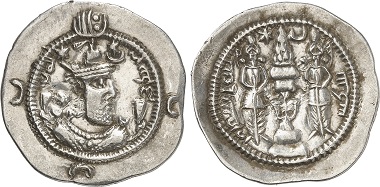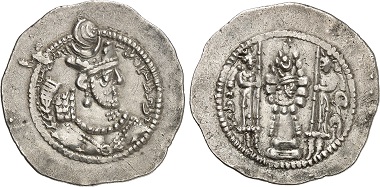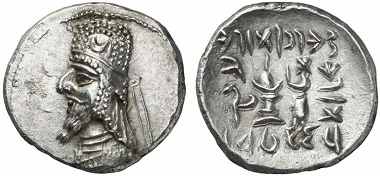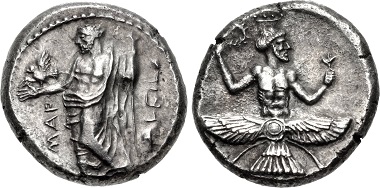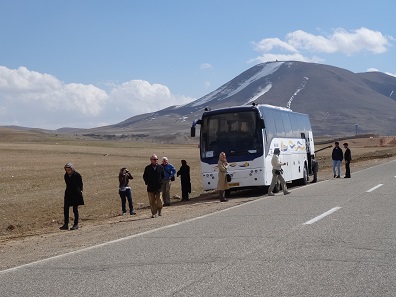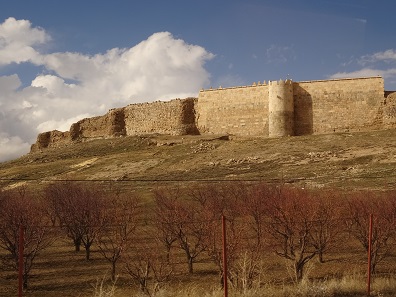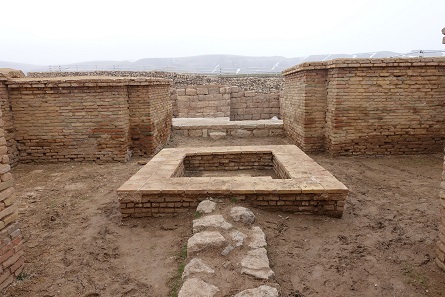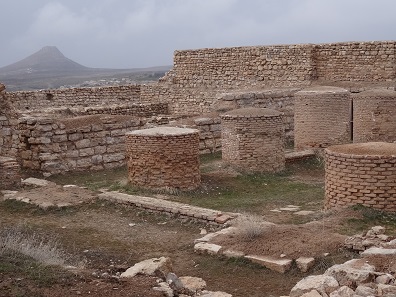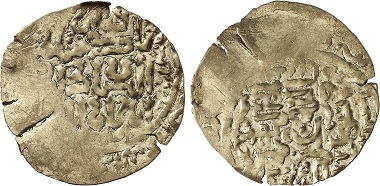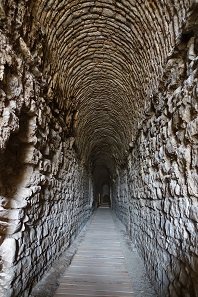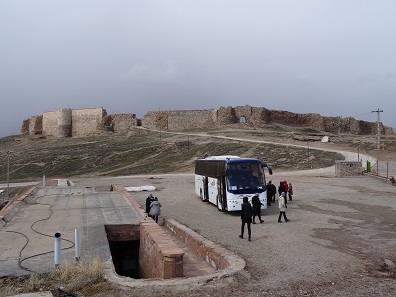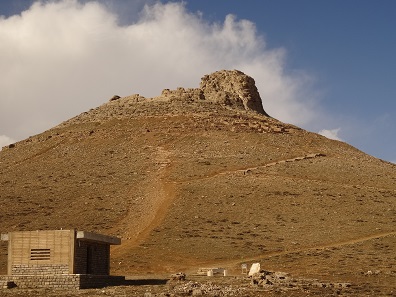by Ursula Kampmann
translated by Teresa Teklic
April 21, 2016 – Have you ever taken a closer look at a Sassanid drachm?
Khosrow I, 531-578. Drachm. Rv. Fire-altar in between two figures. From Gorny & Mosch auction sale 237 (2016), 1561.
The reverse of each drachm depicts a fire-altar flanked by two men.
Varhran V, 420-438. Drachm. Rv. Fire-altar with the king’s bust in between two figures. From Gorny & Mosch auction sale 237 (2016), 1542.
Sometimes there would even be a small head emerging from the flames.
The depiction of this fire-altar is supposed to represent the personal king’s fires which were lit as a ritual when someone ascended to the throne – probably (also) in Takht-e Soleyman. The lighting of the fire marked the beginning of the Sassanid kings’ rule, the starting point at which each king’s era is dated. Such king’s fires, by the way, already existed under the Persians and the Parthians.
It is not entirely clear who the two figures next to the fire are. It could be the king himself and what is termed “Khvarenah”, his “royal glory”. Perhaps it is also the king with his predecessor or with a priest. We don’t know.
Persis. Dareius II, 1st century BC. Rv. King offering a sacrifice in front of the burning fire-altar. From Gorny & Mosch auction sale 207 (2012), 449.
What we do know is that the fire-altar did not only find its way onto coins under the Sassanids. The reverse of coins minted under rulers in the Persis region, from the House of Vadfradad IV, who ruled the country first under Seleucid, then under Parthian suzerainty, depicts the king praying in front of a fire-altar.
All the variations of the reverse allude to the worship of Ahura Mazda as it was preached by Zoroaster. There is little secured knowledge on this Zoroaster. The debate about his lifetime alone is outright adventurous. Opinions differ by a whole millennium between 1,700 and 600 BC. Of course we are also in the dark when it comes to his vita. He is supposed to have been a shoemaker (or not) before he began to preach his new religion at age 30.
Mallos. Tiribazus, Persian satrap of Lydia. Stater, 384-383. Rv. Ahura Mazda. From CNG auction sale, Triton XVIII (2015), 51.
Zoroaster wrote down the revelations of his God in the Avesta, which became the principal scripture of Zoroastrianism. In it he describes Ahura Mazda as the benevolent creator of the world, who sends good spirits to those who believe in him: virtue and truthfulness, humility and respectability, health and fortune.
A world ruled by Ahura Mazda would be perfect but already in 600 BC the world wasn’t good enough that a benevolent God could have been made responsible for it. There is evil or, as Zoroaster calls it, Angra Mainyu, which sends an evil spirit for every good one Ahura Mazda sends to the humans.
And it now remains up to the faithful to decide between Ahura Mazda and Angra Mainyu. Their decision has consequences for their life in the afterworld, where a bridge leads to the land of eternal bliss. For the good ones this bridge is as wide as a path. For the bad ones it is as narrow as a knife blade. A fall into the abyss, into hell, is irreversible.
Already the Persians, followed by the Parthians, worshipped Ahura Mazda. The cult took on a major role in the Sassanid Empire. It never became the only state religion, however, although some religious zealots, like the priest Kartir, tried to enact that (you’ll hear many more interesting details about this man in the Persepolis episode).
That the most important family celebration for the Iranians, Newroz, goes back to ancient Persian traditions shows just how central the Zoroastrian heritage is in Iran. But more of that later. After all we were lucky enough to be part of such a family celebration.
Anyway. One of the most important Sassanid sanctuaries lies on the Takht-e Soleyman and that is at the back of beyond …
Escape to the solitude of the mountains. The landscape was at least as spectacular as our destination. Photo: KW.
Sunday, 6 March 2016
Don’t ask me when we got up in the morning! It was cruel and when the alarm went off I had a really hard time remembering why I had wanted to travel Iran in the first place. Well, eventually we had all gotten on the bus. And at some point our eyes would stay open without a conscious effort. And we were on the way, although not on the way that the map would have suggested. This map shows a beautiful new road of 150 km length, on which a normal passenger car would be at the destination in 2 ? hours. We did not take that. Why? I have no idea. According to our local guide Ehsan busses weren’t permitted on the road. Mrs Hodel had taken it the last time she was there anyway. And it soon dawned on us that the schedule for the day was based on the kilometre count from last time, meaning we would get to our hotel in the evening not just late but rather very late. We took a huge detour through Bischar, which practically doubled the way. Then Ehsan left the bus (and all of us in it) waiting in some village for half an hour because he hadn’t had time/ hadn’t felt like it/ had simply forgotten to buy lunch packages for us the previous night. And when we were on our way again at last, the bus broke down.
Unexpected stop in the solitary mountains. Photo: KW.
It was broken. Not completely, but broken enough not to try and drive off into the solitude of the Iranian mountains. So we turned around, to the village that we had just set off from.
A garage was quickly located because everything that looks like a small town in Iran has an avenue of garages leading into the town centre. On the outside their door signs show Mercedes, Porsche and sports cars. Inside are more modest Peugeot models from local factories. I correct, most of the time they are parked outside because the garages are so narrow that by no stretch of the imagination can I think how to get a car in there and back out.
Nevertheless, within an hour our driver Nadir and the manager of the garage had fixed our technical problems sufficiently so that we dared to drive to Takht-e Soleyman.
Fortification walls surrounding the fire-temple. Photo: KW.
By now it was a rather late early afternoon. The long driving hours had tired me out somewhat. But when the impressive fortification walls came into sight my jaw still dropped.
Water canals. Photo: KW.
The atmosphere was incredible. The only sounds were the icy wind and the small rivulets which burbled along the paths. It had started snowing. After all we were at an altitude of 2,200 m. What a surprise when the water in the canals turned out to be pleasantly warm!
Lake in the middle of the sanctuary. Photo: KW.
The mystery was solved when we entered the former sanctuary. There was a lake in the middle of it. It derives its water directly from the ground but due to its high mineral content is not suitable for drinking. Still, this lake is a natural wonder of outstanding beauty, which was probably the reason the Achaemenids worshipped their gods in this place.
Sassanid fire-temple. The ancient fire-altar used to be where the brick platform is today. Photo: KW.
The Sassanids built a fire-temple here that the king himself had to visit regularly. It was, after all, one of the three most important places of worship in the Empire, the one that was dedicated to the warriors and to the king.
The central ceremonies took place in a building, presumably covered by a dome, in the centre of which stood the fire-altar. The place is indicated by a brick top which protects the actual excavation.
Storage room, archive and treasure chambers; a coin hoard was discovered here. Photo: KW.
Next to it you could see several smaller rooms that served as storage rooms, archive and probably also as treasure chambers. Just for the “numismatists among us”, Mrs Hodel had read up on the two coin hoards which were found here!
The rest of the Ilkhanate palace. Photo: KW.
The southern half of the sanctuary doesn’t give away its Sassanid origins anymore because the Ilkhanid ruler Abaqa had a giant hunting seat built here in the second half of the 13th century.
Ilkhanates. Abaqa, 1265-1282. Denarius, Astrabad. From Gorny & Mosch auction sale 234 (2015), 5168.
Abaqa was the second Mongolian Il-khan of Persia and well known in the West since he had attempted, with the help of a delegation sent to Gregory X, to form an alliance against the Mamelukes with the crusaders. This alliance never happened because the crusaders had just agreed to a 10-year armistice with the Mamelukes. The Mongolian army failed to conquer Syria despite the 50,000 Mongols and 30,000 allies it comprised. A second attempt was never made as Abaqa had drunk himself to death – not unusual among the Mongols at the time.
Look into a vaulted corridor – of course the result of restoration works, but of well executed ones. Photo: KW.
Don’t forget that Takht-e Soleyman has been recognised as a UNESCO World Heritage Site since 2003. Those who know that travel agencies put together their travel routes so that they can promote their programmes by saying they have the highest number of world heritage sites possible, will be surprised to learn that we were all alone. Only a few young men carrying a drone were scrambling over the ruins. They turned out to be reporters for National Geographic, who were shooting a film about Takht-e Soleyman. So if, in the near future, you see a documentary about this place that has a group of tourists walking down this vaulted corridor, that will be us.
Infrastructure of the World Heritage Site Takht-e Soleyman. Photo: KW.
Perhaps I should say a few words about the infrastructure of Takht-e Soleyman. There were toilets, at least. More precisely, subterranean squat toilets which had apparently not been cleaned for several days. To be fair, there also hadn’t been enough visiting tourists to get them really dirty during this time. But the red-brown soil that had been washed up in the toilets and covered the lower half of the cabins evoked very different, very unappetizing associations for some fellow travellers …
Restaurants? Negative, and that within a perimeter of several dozen kilometres. Which was why Ehsan had had to shop for a picnic. It would be the first of many packed lunches that we owed to the fact that tourism in Iran is still in its infancy.
Zendan-e Soleyman. Photo: KW.
It was already late when we took off again, passing by the prison of Solomon, Zendan-e Soleyman, a 100 m deep crater. We still had five good hours of driving ahead of us. Which meant we had to skip the mausoleum towers that we were supposed to see that day (which, honestly, I wasn’t too sad about as I still don’t get the beauty of Muslim mausoleum towers …). But, we were promised, we would make up for that another time.
And then we were driving, and driving, and driving, and it got dark, and we were still driving until we finally arrived in Tabris some time shortly before 9 pm. That was exciting because we passed a street in which nothing but furniture was sold. Let’s put it that way: The Iranian taste in furniture is not exactly compatible with ours, quite the contrary. We found the monstrous Baroque-style imitations with their gilded arm rests and crestings more enjoyable than stylish. And it became more and more enjoyable when we passed the same shops for the second and third time, less so when we passed them for the fourth and fifth time until we finally arrived at our hotel. Right in the centre of Tabris, an awful location traffic-wise but certainly the best building on-site. Which doesn’t mean that we were happy with our rooms though …
Our rooms were big, so big that an Iranian extended family with several children and grandchildren (and perhaps a few goats) would have comfortably fitted in there. On the downside, the linens were missing and neither were there any in the other two beds so that we had to sleep right underneath the clean-looking, red, fake fur blankets. Although actually we would not have needed the blankets at all since the heating was on full power and despite all our efforts wouldn’t turn off. We tore the windows wide open but the noise of the nightly street traffic rendered all rest impossible. The compromise we found was tearing the windows wide open when we left the rooms and closing them once we returned. That left us at least half the night before the heating had warmed up the room sufficiently to make it uncomfortable …
Let me also make a few remarks on the bathrooms. They are somewhat special in Iran. Mrs Hodel thinks that’s because there is no proper vocational training for skilled crafts and trades in the country. The fact remains that each hotel room possesses a couple of high-heeled plastic shoes, whose sole function is entering the bathroom with dry feet: Shower, toilet, or sink, one of the three sanitary installations will most certainly have a leak.
In our case it was the well-known problem that the toilet would only occasionally flush, when there was sufficient water and no one else was using it. There was an emergency option though: Apart from the typical Western-style toilet, there was an additional squat toilet, which many Iranians seem to prefer to the Western model anyway.
Completely knackered we curled up underneath our fake fur blankets with the happy prospect of getting at least one more hours of sleep this night …
The fourth part of my Iranian travelogue takes us to the tomb of Jude the Apostle and the reason why the Armenian Church is autocephalous according to canon law. We also take a walk around the bazaar of Trabis and make a trip to an Iranian Cappadocia, where we watch an innkeeper slaughter a lamb for his dinner.
You can find all episodes of the Iranian Diary here.



